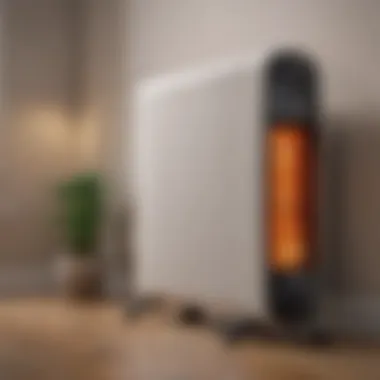Exploring Energy-Efficient Electric Heaters


Intro
As the world increasingly leans towards energy efficiency and sustainability, the focus on electric heaters becomes essential. These devices are designed to provide warmth and comfort while minimizing energy consumption. This article explores the most energy-efficient electric heaters available today, offering insights into their various technologies, and performance metrics, and highlighting the best options to suit different needs.
In our quest for the ideal heating solution, it is crucial to understand the key innovations driving the industry. With an array of products on the market, homeowners face the challenge of selecting the right heater that balances cost-effectiveness and sustainability. By understanding each product's features and metrics, one can navigate the vast options and choose wisely.
Electric heating has transformed significantly in recent years, moving towards more sustainable solutions that promise lower energy bills and a reduced carbon footprint. This exploration contains substantial information that aims to inform readers and assist them in making educated choices about their home heating systems.
Foreword to Electric Heating
Electric heating is a pivotal aspect of modern home climate control. It utilizes electric energy to provide warmth, offering a range of options suitable for various living spaces. As we increasingly prioritize energy efficiency and sustainability, understanding electric heating becomes essential. This section provides an overview of electric heating systems and their significance in contemporary households.
The primary advantage of electric heaters is their ease of installation and use. Unlike traditional heating systems that may require extensive ductwork or fuel storage, electric heaters are generally standalone units that can be installed in any room with access to electrical outlets. This makes them a practical option for many homeowners.
Another critical aspect is the control mechanisms available. Many electric heaters come with programmable or smart features, enabling customized heating schedules. This can lead to significant energy savings. Homeowners can fine-tune their heating needs, ensuring that warmth is provided only when necessary.
Additionally, electric heating tends to produce cleaner energy outputs when compared to fossil fuel systems. With rising concerns about air quality and environmental sustainability, electric systems align more closely with contemporary values centered on reducing carbon footprints.
"Understanding the ins and outs of electric heating can greatly influence energy efficiency in homes across various contexts."
In summary, this section highlights the relevance of electric heaters in homes today. The convenience they offer, combined with their potential for enhanced energy efficiency, makes them an essential consideration for individuals seeking effective heating solutions. As we move deeper into this article, we will explore various models and types of electric heaters, assessing their energy efficiency and features to guide informed decisions in heating technology.
Understanding Energy Efficiency
Understanding energy efficiency is at the core of optimizing electric heaters. It affects energy usage, cost, and environmental impact. By focusing on energy efficiency in electric heaters, homeowners can not only save on electricity bills but also contribute positively to reducing their carbon footprint. This component serves as a key consideration in selecting heating options that fulfill both functional and sustainable demands.
Definition of Energy Efficiency
Energy efficiency refers to using less energy to provide the same service. In the context of electric heaters, it indicates how effectively a heater converts electrical energy into heat. Better efficiency means more heat produced per unit of energy consumed. Typical measurements include the heater's wattage, the thermal efficiency rating, and even additional features like programmable thermostats. For instance, a heater with a high energy efficiency rating can deliver comfort while keeping electricity costs low.
Importance in Electric Heaters
The importance of energy efficiency in electric heaters cannot be overstated. First, it leads to significant cost savings. An energy-efficient heater consumes less power over time, which directly results in lower monthly energy bills. Additionally, many electric utility companies offer reduced rates for homes that utilize efficient heating technologies.
Second, energy-efficient systems are crucial for environmental sustainability. Lower energy consumption translates into reduced greenhouse gas emissions from power plants, making it a responsible choice for homeowners looking to minimize their environmental impact.
Furthermore, using energy-efficient heaters often means better performance. High-efficiency models may heat spaces more evenly and effectively. When shopping for a new heater, consumers should prioritize these efficiency metrics. In summary, understanding energy efficiency boosts financial savings, environmental integrity, and overall heating quality.
Types of Electric Heaters
In understanding energy-efficient electric heaters, knowing the different types is crucial. Each type brings unique advantages and considerations that can meet specific heating needs. This section examines four distinct categories of electric heaters, detailing their workings, pros, and cons. By understanding how each operates, homeowners can make educated choices that align with personal preferences and energy consumption goals.
Convection Heaters
Convection heaters operate by warming air in the room. They utilize a fan or natural convection to circulate heated air throughout the space. This process can effectively raise the ambient temperature, making it suitable for larger areas.
One key benefit of convection heaters is their ability to provide consistent warmth. They can be left running for longer periods without the risk of overheating. However, it may take time for the entire room to reach the desired temperature, particularly in poorly insulated spaces. Additionally, these heaters often consume more energy than other types, which can lead to higher electricity bills.
Pros:
- Even heat distribution
- Suitable for larger areas
- Low risk of overheating
Cons:


- Slower to heat a room
- Can be energy-intensive
Radiant Heaters
Radiant heaters work differently by emitting infrared radiation. Instead of warming the air, they heat solid objects and people in their vicinity. This feature allows for quick warming, making radiant heaters ideal for spot heating. They are often compact and easy to use. While radiant heaters can provide immediate comfort, they offer limited coverage. If someone is sitting outside the heat zone, they will not benefit from the warmth. Moreover, radiant heaters can be less energy-efficient for whole-room heating, as they are designed for targeted areas.
Pros:
- Quick heat-up time
- Ideal for localized heating
Cons:
- Limited coverage area
- Less effective for whole rooms
Infrared Heaters
Infrared heaters are a subcategory of radiant heaters but focus on a specific range of wavelengths. They directly warm up objects and people instead of the air itself. This technology is increasingly popular due to its efficiency. Because they don't have to heat all the air in a space, they can lead to reduced energy consumption. Infrared heaters are often lightweight and portable, making them handy for various settings. On the downside, their effect diminishes with greater distances. The farther away one is from the heater, the less effective it becomes. Also, they may require a longer warm-up time compared to other types.
Pros:
- Highly energy-efficient
- Targeted heating reduces energy waste
Cons:
- Effectiveness decreases with distance
- May have longer warm-up times
Micathermic Heaters
Micathermic heaters utilize mica panels to generate heat. They combine both convection and radiant heating methods. One significant advantage is their ability to heat spaces quickly while providing a consistent temperature. These heaters are also relatively lightweight and slim, making them easy to position in various areas of the home. However, micathermic heaters can be pricier than traditional options. They may also have specific placement requirements to optimize their performance. A downside is they are less effective for larger rooms compared to convection heaters.
Pros:
- Fast and uniform heating
- Slim, elegant design
Cons:
- Higher initial cost
- Less suitable for very large spaces
Understanding the differences among electric heater types enables homeowners to select the most energy-efficient and suitable option for their requirements.
Key Considerations for Energy Efficiency
When selecting an electric heater, understanding the key considerations for energy efficiency plays a crucial role. It defines not only how effectively a heater can warm a space but also impacts ongoing energy costs. Each factor contributes to overall performance, guiding homeowners towards making well-informed decisions.
Wattage and Its Impact
Wattage represents the amount of energy consumed by an electric heater. Higher wattage typically correlates with increased heating output. However, it’s essential to consider the room size as well. For instance, a heater with 1500 watts may adequately heat a small room, while a larger space may require multiple units or a higher watt heater. The energy consumption also affects electricity bills. Choosing the right wattage can ensure sufficient heating without excessive use of energy.
Thermostat Control
Thermostat control is vital in maintaining an efficient heating process. Heaters with programmable thermostats allow users to set specific temperatures and schedules. This capability can prevent unnecessary energy use when spaces are unoccupied. Moreover, smart thermostats, which adapt to a user’s routine, can optimize settings further. This can lead to significant savings in energy costs over time, highlighting the importance of selecting a heater equipped with this functionality.
Insulation Effectiveness


Insulation in a home directly influences the efficiency of electric heating. If a room is not well-insulated, heat escapes, leading to increased energy consumption as the heater works harder to maintain temperature. Improving insulation can include sealing cracks, adding weather stripping, or utilizing energy-efficient windows. By investing in insulation, homeowners not only enhance comfort but also reduce their reliance on electric heating, thereby lowering energy costs.
Placement and Usage
The strategic placement of electric heaters can optimize their effectiveness. For instance, placing a heater in a central location can enhance distribution of warmth throughout the area. Furthermore, using heaters in conjunction with natural heat sources, such as sunlight, can also bring about energy savings. It’s advisable to refrain from placing heaters behind furniture or curtains, as this can obstruct heat flow and result in inefficient operation. Understanding where to place a heater and how to use it effectively can drastically affect performance and energy usage.
Choosing the right electric heater involves considering wattage, thermostat capabilities, insulation, and strategic placement. An integrated approach to these factors can enhance comfort while minimizing costs.
Top Energy-Efficient Electric Heaters
The title of this section speaks to one of the most crucial considerations for homeowners and individuals seeking efficient heating solutions. Evaluating top energy-efficient electric heaters is essential in an era where energy conservation is pivotal. These heaters not only provide warmth but also help minimize energy expenses. Understanding which models excel in efficiency allows consumers to save money and contribute to environmental sustainability.
When choosing an electric heater, factors such as efficiency ratings, design, cost and features become important. The right choice can enhance comfort while reducing carbon footprint. In this review, we will dissect specific models and brands, offering insights that can inform your buying decision.
Model Comparisons
Features and Specifications
In assessing electric heaters, the features and specifications are foundational. Key characteristics include wattage, heating technology, and additional functionalities such as timers. For instance, a heater with a programmable thermostat allows users to regulate the room temperature efficiently, ensuring hot air is produced only when needed. This can lead to energy savings.
Moreover, certain heaters come with safety and convenience features that enhance usability. A unique feature is some models have tip-over protection, which contributes to safety in households with children or pets. This characteristic provides peace of mind but may increase the initial cost.
Performance Ratings
Performance ratings serve as a critical metric in determining the effectiveness of electric heaters. These ratings often derive from user feedback and energy audits conducted by third parties. Factors like heat output, efficiency at different power settings, and durability contribute to the ratings. A key characteristic here is that heaters with higher ratings tend to consume less energy while providing robust heating capabilities.
However, while high-performance heaters can lead to long-term savings, the up-front financial investment might be higher. Weighing these pros and cons is essential for making a smart purchase.
Brand Analysis
Leading Manufacturers
The leading manufacturers in the electric heating industry have established a reputation based on reliability and innovation. Brands like Lasko and De'Longhi have consistently ranked high for their efficient models. The hallmark of these brands includes not only energy efficiency but also compatibility with modern home requirements. The unique feature of brand reputation helps ensure quality and customer support.
It’s worth considering that certain manufacturers offer extended warranties, which enhances the overall value proposition. While these leading brands may come with a higher price tag, the investment often pays off in terms of durability and performance.
Consumer Reviews
Consumer reviews play a pivotal role in shaping perceptions about electric heaters. Feedback from fellow users provides insights into day-to-day functionality and performance. Review platforms often highlight common issues like noise levels or heating speed, allowing prospective buyers to make informed choices.
Additionally, consumers frequently discuss advantages like lower utility bills, which reflects the efficiency of the models they choose. However, it is crucial to differentiate between verified reviews and those that may be sponsored or biased. Analyzing consumer reviews is beneficial but should be done cautiously to ensure a well-rounded understanding of a product's capabilities.
Costs Associated with Electric Heating
Understanding the costs associated with electric heating is crucial for homeowners looking to create warm and inviting spaces while managing their budget. This section will explore three main aspects of costs related to electric heating: initial investments, long-term energy costs, and potential rebates or incentives. Making informed decisions about these factors can lead to significant savings.
Initial Investment
The initial investment in electric heating systems can vary depending on the type of heater selected. Costs typically include the purchase price of the heater and any installation fees. For example, convection heaters might have a lower upfront cost compared to infrared heaters, yet the installation process may differ.
Several factors influence initial investment:


- Heater Type: Different models, like micathermic or radiant heaters, also have unique price ranges.
- Installation Requirements: Some systems may need professional installation, adding to costs, while others are portable and can be set up easily.
- Energy Efficiency Ratings: Buying a model with a high energy efficiency rating can lead to better performance but may come with a higher price tag upfront.
Long-term Energy Costs
Long-term energy costs are an essential consideration when selecting electric heaters. These costs can accumulate over time, affecting the overall expense of heating your space. Understanding energy consumption is key:
- Wattage: The wattage of a heater directly impacts energy use. A higher wattage equates to more energy consumed. However, this depends on usage patterns and the efficiency of the heater.
- Heating Needs: Factors like the size of the room and insulation quality will determine how often and how effectively an electric heater is utilized, impacting ongoing energy bills.
- Energy Plans: Look into your local electricity rates. Some regions offer different pricing for peak and off-peak hours, which can influence costs significantly if the heater is used during peak times.
Potential Rebates and Incentives
Homeowners should also explore potential rebates and incentives that might be available for using energy-efficient electric heating systems. These can lessen the financial burden of installation and encourage environmentally friendly choices.
Investigate the following to maximize savings:
- Local Government Programs: Many municipalities have specific programs that offer financial help when purchasing energy-efficient appliances.
- Utility Company Offers: Check with your electricity provider for available rebates on energy-efficient heaters or incentives for reducing energy consumption.
- Tax Credits: In some cases, installing energy-efficient systems may qualify for federal or state tax credits. Research eligibility requirements beforehand.
"Understanding both the immediate costs and long-term implications of electric heating can empower homeowners to make wiser choices about their heating options."
In summary, evaluating costs linked with electric heating encompasses more than just the initial purchase price. Long-term expenses and available incentives play a significant role in shaping overall investment. Make sure to analyze these elements thoroughly to ensure a cost-effective and energy-efficient heating solution.
Best Practices for Maximizing Efficiency
Maximizing energy efficiency is essential for anyone using electric heaters. It not only helps in reducing energy consumption but also contributes to cost savings over time. Implementing effective strategies ensures that homeowners, interior design enthusiasts, party hosts, and gardening aficionados get the best out of their electric heating systems. Practicing these strategies can significantly enhance a heater's effectiveness and longevity.
Regular Maintenance
Regular maintenance is crucial for extending the life of electric heaters while maintaining optimal performance. Dust and debris can accumulate within the heating units, causing inefficiency and even potential hazards. Schedule periodic inspections to ensure that all components function correctly.
- Clean filters: Often, electric heaters have filters that need cleaning or replacement. Dirty filters restrict airflow, reducing efficiency. Keeping these clean allows for better air circulation.
- Inspect wiring and connections: Regularly check for any frayed wires or loose connections. Malfunctions in these areas can cause energy loss and risks of fire.
- Professional servicing: Consider hiring a professional every few years to do a comprehensive check. They can identify issues that may not be visible to the untrained eye.
Optimizing Usage Patterns
Understanding how and when to use electric heaters can lead to substantial energy savings. Setting heating times and temperatures efficiently can make a marked difference in energy bills. Here are several factors to consider:
- Program your thermostat: Utilize programmable thermostats to adjust heating schedules based on daily routines. You can lower temperatures during uncomfortable sleeping hours or when the home is unoccupied.
- Zone heating: Instead of heating the entire house, focus on specific rooms or areas. Portable heaters can provide targeted heat where it’s needed most, reducing overall energy usage.
- Avoid temperature extremes: Setting the temperature drastically high or low can lead to increased energy consumption. Aim for a moderate temperature.
Upgrading Insulation
Insulation plays a vital role in retaining heat. Upgrading insulation can prevent heat loss and allow electric heaters to operate more efficiently.
- Identify drafts: Check areas around doors and windows for drafts. Use weather stripping or drafts stoppers to block cold air from entering.
- Insulate walls and ceilings: Proper insulation in walls and ceilings can help maintain a consistent indoor temperature, making heating more efficient.
- Consider energy-efficient windows: Installing double or triple-glazed windows minimizes heat loss and can complement your heating strategies smoothly.
"Proper insulation is key to keeping your heating system efficient and effective."
By adhering to these best practices, homeowners can enhance the efficiency of their electric heaters. Not only do these practices contribute to energy conservation but they also promote a more sustainable approach to home heating. With the right maintenance, usage patterns, and insulation improvements, it is possible to achieve a significantly lower energy footprint.
Finale
In summarizing the exploration of electric heaters, it is essential to recognize the significance of energy efficiency in today’s context. Electric heaters not only provide warmth but can also play a crucial role in reducing energy costs and minimizing environmental impact. Homeowners need to understand that their choice of heater can affect their monthly bills and the carbon footprint of their homes.
Electric heating technology advances are constantly evolving, and staying informed about the latest developments can lead to smarter choices. The benefits of selecting an energy-efficient electric heater are manifold. Such devices often translate to lower utility costs and can contribute to better overall energy conservation.
When considering various models, several factors must be taken into account:
- Initial costs versus long-term savings: Although some energy-efficient models may have a higher upfront price, their lower operating costs can provide better savings in the long run.
- Manufacturer reliability: Choosing reputable brands with proven track records in energy efficiency is critical.
- Features that enhance performance: Options like programmable thermostats and smart home integration can add to the efficiency of electric heaters.
"The key to an efficient electric heating system lies not just in the device itself but also in how effectively it is used within the home environment."
Moreover, adequate home insulation plays a vital role in maximizing the efficiency of electric heaters. Proper insulation reduces heat loss and helps maintain a stable indoor temperature. This means that even a less powerful heater can effectively warm the space without excessive energy consumption.



